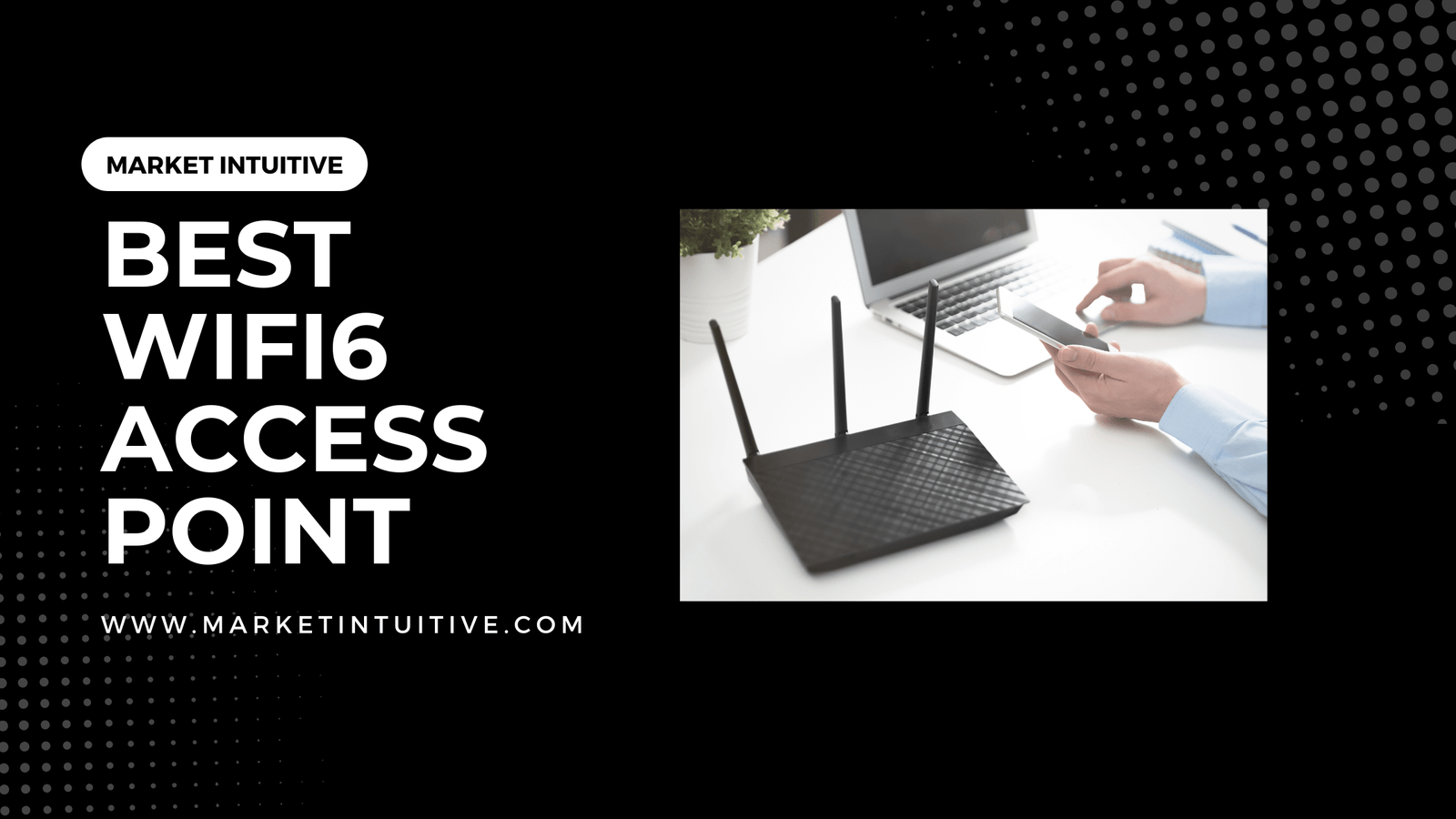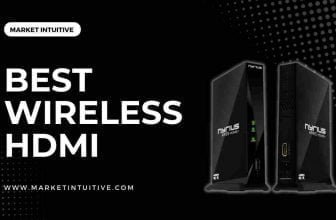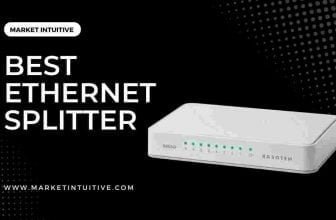5 Best WiFi6 Access Points For Fast & Easy Connectivity

Have you ever experienced buffering or lag while streaming your favorite show or playing an online game? Slow internet speed can be frustrating and make you lose your focus. But worry no more because the solution lies in the best WiFi6 Access Points.
These access points offer high-speed internet, extensive coverage, and low network congestion, revolutionizing your internet experience. However, with many options available, it can be a daunting task to choose the best WiFi6 Access Points for your needs.
That’s why I’ve done the research and compiled a list of the best options available for you to make the right choice. Join me as I explore the world of WiFi6 Access Points, and discover how you can take your internet connectivity to the next level with the latest in wireless technology.
Understanding Wi-Fi 6
Wi-Fi 6, also known as 802.11ax, is the latest generation of Wi-Fi technology, designed to bring faster speeds, improved efficiency, and better performance to wireless networks. In this section, we will discuss some of the key features and benefits of Wi-Fi 6 over its predecessor, Wi-Fi 5 (802.11ac).

Wi-Fi 6 Features
If you’re considering an upgrade to the best WiFi6 Access Points, it’s crucial to understand the benefits and features of this latest wireless technology.
- OFDMA (Orthogonal Frequency Division Multiple Access): Wi-Fi 6 introduces OFDMA, a technology that allows multiple devices to share the same channel simultaneously, resulting in improved network efficiency and reduced latency. This means that more devices can be connected and communicate at the same time without causing congestion.
- MU-MIMO (Multi-User Multiple Input Multiple Output): Wi-Fi 6 expands on the number of devices that can simultaneously communicate with the access point using MU-MIMO, increasing from four in Wi-Fi 5 to eight in Wi-Fi 6. This improvement results in greater capacity and better performance for multi-device networks.
- 1024-QAM (Quadrature Amplitude Modulation): Wi-Fi 6 incorporates 1024-QAM, which allows for higher data rates compared to the 256-QAM used in Wi-Fi 5. This results in faster wireless speeds, up to 37% faster single-user data rates in Wi-Fi 6.
- Backward Compatibility: Wi-Fi 6 is designed to be backward compatible with previous Wi-Fi standards, meaning that Wi-Fi 6 access points can still connect to older devices using Wi-Fi 4 or Wi-Fi 5 standards. This ensures a smooth transition to the latest technology without the need to replace all existing devices.
Benefits Of Wi-Fi 6
Upgrading to the best WiFi6 Access Points offers a range of benefits. Let’s discuss them in detail below:

- Faster Speeds: With the introduction of technologies like OFDMA, MU-MIMO, and 1024-QAM, Wi-Fi 6 provides faster speeds and stronger connections than Wi-Fi 5.
- Greater Network Efficiency: Wi-Fi 6 is designed to handle multiple devices more efficiently, reducing latency and improving overall network performance.
- Improved Battery Life for Devices: Wi-Fi 6 introduces a feature called Target Wake Time (TWT), which helps reduce power consumption by allowing devices to schedule their communication with the access point. This results in longer battery life for devices connected to the network.
- Better Performance in Congested Environments: Wi-Fi 6 is better equipped to handle congested environments, like apartment buildings or public spaces, thanks to its improved capacity and management of multiple devices.
By understanding the features and benefits of Wi-Fi 6, you can make a well-informed decision when it comes to upgrading your wireless network. Whether it’s for your home or office, Wi-Fi 6 access points can provide a significant improvement in performance, efficiency, and coverage.
Top Wi-Fi 6 Access Points
As Wi-Fi 6 technology gains popularity, the market is flooded with numerous access points catering to different needs and budgets. In this section, we will discuss some of the best Wi-Fi 6 access points available, with a focus on both budget-friendly and high-performance options.
Budget-Friendly Options:
- TP-Link EAP610: The TP-Link EAP610 is an ultra-slim wireless access point that offers true Wi-Fi 6 AX1800 speeds. With seamless roaming and WPA3 security, it is an affordable option for those looking for a reliable Wi-Fi 6 access point. Its Omada Mesh technology ensures a strong, consistent signal throughout your space.
- Netgear WAX214: Another budget-friendly option, the Netgear WAX214 is a Wi-Fi 6 PoE+ access point that provides 802.11ax connectivity on both 2.4GHz and 5GHz bands. With a 1 x 1G Ethernet PoE port, this access point can support up to 128 devices simultaneously while offering WPA3 security and MU-MIMO technology.
High-Performance Options:
- Netgear WAX620: The Netgear WAX620 is a high-performance Wi-Fi 6 access point that boasts impressive speeds, coverage, and security features. This access point is designed for demanding environments and can handle a large number of devices without compromising performance.
- Ubiquiti U6-LR: For those in need of a Wi-Fi 6 access point capable of covering a larger area, the Ubiquiti U6-LR is an excellent choice. With its advanced antenna design, this access point can deliver fast Wi-Fi 6 speeds over a coverage area of up to 1,750 square feet. The U6-LR is also easy to set up and manage using the Ubiquiti UniFi app, making it a suitable option for high-density environments.
- Zyxel WAX650S: The Zyxel WAX650S is another high-performing Wi-Fi 6 access point with a focus on speed, coverage, and reliability. Its advanced features, such as intelligent channel selection and load balancing, ensure a smooth and consistent Wi-Fi experience for all connected devices.
In conclusion, when choosing the best Wi-Fi 6 access point, it’s essential to consider your specific needs, the size of the area you need to cover, and your budget. With various options available, there’s sure to be a Wi-Fi 6 access point that meets your requirements.
Configuration and Management
Maintaining a Wi-Fi 6 access point should be effortless with the right tools and systems in place. In this section, we will discuss two popular management solutions: Omada SDN and Omada Controller, and Cloud-Based Solutions.
Omada SDN and Omada Controller
Omada SDN (Software-Defined Networking) and Omada Controller are powerful tools designed for managing Wi-Fi 6 access points easily. These solutions offer:
- Centralized management and control of all connected devices, including access points, switches, and gateways.
- Simplified configuration through an intuitive web interface or mobile app.
- Seamless roaming for improved user experience in mesh Wi-Fi environments.
- Support for PoE and PoE+ switches, reducing the need for additional power adapters and cables.
- Advanced security features like WPA3 encryption and multi-factor authentication.
Some Wi-Fi 6 access points, like the TP-Link EAP610, come with built-in Omada SDN and Omada Controller support, making setup and management a breeze.
Cloud-Based Solutions
Cloud-based management solutions for Wi-Fi 6 access points offer flexibility and scalability:
- Remote access and control of your Wi-Fi 6 network from anywhere.
- Real-time monitoring and analytics to track network performance, user activity, and troubleshoot issues.
- Automatic firmware updates and backups to keep your network up-to-date and secure.
- Integration with various IoT solutions, enabling rapid deployment of IoT applications and indoor services.
Companies like Cisco provide cloud-based management solutions, leveraging Wi-Fi 6/6E access points as gateways for IoT services in Cisco Spaces.
When choosing a Wi-Fi 6 access point, consider the management solutions available and ensure they meet your needs for configuration, PoE support, mesh Wi-Fi, and cloud access. Keep in mind that advanced features may require additional hardware or software subscriptions. Ultimately, a well-configured and managed Wi-Fi 6 network will enhance your connectivity experience and improve overall network performance.
Coverage and Performance
The best WiFi6 Access Points offer wider coverage and better performance than previous Wi-Fi technologies.
Range and Connectivity
When it comes to Wi-Fi 6 access points, coverage and range are essential factors to consider. The best Wi-Fi 6 access points use beamforming technology, which enables them to focus wireless signals in the direction of connected devices, thereby enhancing signal strength and range. Dual-band support (2.4GHz and 5GHz) is also vital as it allows for better connectivity options and increased bandwidth.
A standout Wi-Fi 6 access point that excels in range and connectivity is the Netgear WAX214. It can handle up to 128 devices simultaneously, making it a great choice for busy households or small offices. Another option worth considering is the Ubiquiti U6-LR, which provides excellent connectivity for larger spaces.
For those looking to cover larger areas or multiple floors, investing in a mesh Wi-Fi system can be a practical solution. These systems consist of multiple access points that work together to create a seamless, extended network with consistent performance throughout the covered area.
Latency and Congestion
With the increasing number of wireless devices in modern homes and offices, network congestion can be a significant issue, leading to slower connections and increased latency. Wi-Fi 6 access points tackle these problems by employing features such as Multi-User Multiple Input, Multiple Output (MU-MIMO), and Orthogonal Frequency Division Multiple Access (OFDMA). MU-MIMO allows access points to communicate with multiple devices at once, while OFDMA increases the efficiency of bandwidth usage.
Some Wi-Fi 6 access points that excel in reducing latency and managing network congestion include:
- TP-Link EAP660 HD: Offers an impressive feature set for managing network traffic.
- Zyxel WAX650S: Known for its robust performance in high-density environments.
- Meraki MR56: Equipped with multigigabit Ethernet and security radio access points, enhancing both connectivity and security.
In conclusion, when evaluating Wi-Fi 6 access points for coverage and performance, be sure to consider factors such as range, connectivity, latency, and congestion management. Access points like Netgear WAX214, Ubiquiti U6-LR, TP-Link EAP660 HD, Zyxel WAX650S, and Meraki MR56 are some of the top choices available in the market to provide reliable and efficient wireless networking solutions.
Security and Access Control
Upgrading to the best WiFi6 Access Points ensures better security and access control, making it a great investment for anyone looking to improve their home or office network infrastructure’s security.
WPA3 Encryption
Wi-Fi 6 access points have improved security features compared to earlier generations, one of which is the support for WPA3 encryption. WPA3 is the latest and most secure Wi-Fi encryption standard. It offers enhanced privacy and provides better protection against dictionary attacks and data eavesdropping. Some of the key features of WPA3 are:
- Simultaneous Authentication of Equals (SAE): This replaces the Pre-Shared Key (PSK) method used in WPA2 and protects the network from unauthorized access through improved password-based authentication.
- 192-bit encryption: WPA3 offers a more robust encryption strength for sensitive networks, making it suitable for use in government and finance sectors.
Other Security Features
In addition to WPA3, Wi-Fi 6 access points often include other security features to keep your network safe and provide granular control over user access. Some of these features are:
- MAC-based Access Control List (ACL): This allows administrators to permit or deny access to the network based on the device MAC address. It provides an additional layer of security and control over network access.
- Multi-factor Authentication (MFA): Some Wi-Fi 6 access points support multi-factor authentication which adds an extra layer of protection by requiring users to confirm their identity using more than one authentication method (e.g., password and phone verification).
- Virtual Local Area Networks (VLANs): By supporting VLAN tagging, Wi-Fi 6 access points can segment the network into multiple subnets. This helps isolate different groups of devices, improving overall security and reducing the impact of potential threats.
- Rogue Access Point Detection: Advanced security features in some Wi-Fi 6 access points can detect and prevent unauthorized access points (rogue APs) from connecting to your network, mitigating potential security risks.
Wi-Fi 6 access points with these advanced security features not only ensure a more secure wireless experience but also provide improved access control and management for network administrators. However, when choosing a Wi-Fi 6 access point, it is important to consider the security features offered by the specific product, as they may differ from one model to another.
Device Compatibility
The best WiFi6 Access Points offer excellent device compatibility with backward compatibility with previous Wi-Fi versions. They are compatible with a range of devices, including smartphones, laptops, tablets, and IoT devices.

Smartphones and Tablets
Wi-Fi 6 access points are designed to work well with all types of devices, including smartphones and tablets. Most major smartphone manufacturers, such as Apple and Samsung, have started integrating Wi-Fi 6 support into their devices. The latest iPhone, Samsung Galaxy, and Google Pixel models support Wi-Fi 6, offering faster Wi-Fi speeds and improved connectivity with Wi-Fi 6 routers and access points. When using a Wi-Fi 6 access point, you can expect the following:
- Faster download and upload speeds
- Improved energy efficiency, leading to longer battery life
- Higher device capacity, allowing more devices to connect at once
Here’s a list of some popular smartphones and tablets that are compatible with Wi-Fi 6:
- iPhone 12 and newer models
- Samsung Galaxy S21 and newer models
- Google Pixel 6 and newer models
- iPad Pro 5th generation and newer models
Smart Home Devices
Many smart home devices, like security cameras, smart speakers, and smart thermostats, are also beginning to support Wi-Fi 6. This makes them more efficient at communicating with each other and with your devices, resulting in a smoother and more reliable connection. Some popular smart home devices that are compatible with Wi-Fi 6 include:
- Google Nest Wifi
- Ring Alarm Security System (2nd generation)
- Amazon Echo 4th generation
As Wi-Fi 6 becomes more prevalent, more smart home devices will likely adopt this technology, making device compatibility an essential factor to consider when purchasing a Wi-Fi 6 access point.
Laptops and Computers
Wi-Fi 6 is not limited to mobile devices and smart home gadgets. Laptops and computers are also starting to support this technology for improved wireless networking. Many recent models from top manufacturers like Dell, HP, and Lenovo have Wi-Fi 6 compatibility built-in. Here are some laptops and computers that support Wi-Fi 6:
- MacBook Pro (2020 and newer models)
- Dell XPS 13 (2020 and newer models)
- HP Spectre x360 (2020 and newer models)
- Lenovo Yoga 9i (2020 and newer models)
To summarize, Wi-Fi 6 access points are becoming more compatible with a wide range of devices, including smartphones, tablets, smart home devices, laptops, and computers. This improved compatibility results in faster speeds, improved battery life, and more reliable connections, making Wi-Fi 6 an excellent choice for future-proofing your home or office networking environment. Note that for devices that do not natively support Wi-Fi 6, you may still connect them to a Wi-Fi 6 access point, but they will not enjoy the full benefits of Wi-Fi 6 technology.
Wrapping Up
Investing in the best WiFi6 Access Points is an excellent decision for anyone looking to upgrade their home or office network infrastructure. With increased speed, wider coverage, reduced latency, and enhanced security, Wi-Fi 6 provides a better internet experience than previous Wi-Fi technologies.
It is compatible with several devices, including legacy devices, and backward compatible with previous Wi-Fi versions. The best WiFi6 Access Points offer excellent device compatibility, leading to optimal performance for multiple devices simultaneously.
By upgrading to the best WiFi6 Access Points, you can enjoy faster speeds, better coverage, improved device compatibility, and advanced security features, enhancing the overall experience of internet usage in your home or office.
Frequently Asked Questions
Best WiFi6 Access Point
Wi-Fi 6 is the latest generation of wireless technology, also referred to as 802.11ax or High Efficiency Wi-Fi. It is designed to improve bandwidth, coverage, and stability in comparison to its predecessor, Wi-Fi 5 (802.11ac).
Is Wi-Fi 6 backward compatible?
Yes, Wi-Fi 6 access points are designed to be compatible with previous Wi-Fi standards such as Wi-Fi 5 (802.11ac) and Wi-Fi 4 (802.11n). However, only Wi-Fi 6 devices will be able to utilize the enhancements provided by Wi-Fi 6 access points.
What are some of the best Wi-Fi 6 access points for 2023?
Here are some top Wi-Fi 6 access points for 2023:
Meraki MR56 Indoor Wi-Fi 6 802.11ax with Multigigabit Ethernet and Security Radio Access Point
Netgear WAX620 WiFi 6 Access Point
Netgear WAX214 WiFi 6 PoE Wireless Access Point
TP-Link EAP660 HD WiFi 6 Access Point
Ubiquiti U6-LR Wi-Fi 6 Access Point
Zyxel WAX650S WiFi 6 Access Point
What are some key features to look for in a Wi-Fi 6 access point?
When choosing a Wi-Fi 6 access point, consider the following features:
Bandwidth
Coverage
Congestion management
Stability
OFDMA Technology
MU-MIMO
Network Allocation Vector (NAV)
Target Wake Time (TWT)
Can Wi-Fi 5 access points work with Wi-Fi 6 access points in the same network?
Yes, Wi-Fi 5 access points can be used in the same network as Wi-Fi 6 access points. However, only Wi-Fi 6 devices will be able to utilize the full capabilities of the Wi-Fi 6 access points.
Although we cannot link to specific websites or products, you can learn more about Wi-Fi 6 by visiting authoritative websites like Wi-Fi Alliance, IEEE, or network equipment manufacturers’ websites.






